Scotland's carbon footprint: 2015
Scotland's carbon footprint refers to estimates of Scotland's greenhouse gas emissions on a consumption basis.
This document is part of a collection
Breakdown of Scotland's Carbon Footprint, 1998-2015
Table 1 outlines how the Carbon Footprint has been categorised for this publication.
Table 1. Categorisation of Scotland's Carbon Footprint
| Main Category | Activity | Description |
|---|---|---|
| Greenhouse Gas Emissions from UK Produced Goods and Services | Scottish consumption of UK production | UK production emissions attributable to Scottish final consumption, including manufacturing and transport, international aviation and shipping provided by Scottish operators. |
Greenhouse Gas Emissions Embedded in Imported Goods and Services – By Region of Import
|
Imports used by UK businesses for Scottish consumption | Greenhouse Gas Emissions associated with the production of imports which are used by UK industry and attributable to Scottish final consumption |
| Imports directly used by Scottish consumers | Greenhouse Gas Emissions associated with the production of imports which are used by Scottish final consumers | |
| Greenhouse Gas Emissions Directly Produced By Scottish Residents | Private motoring | Greenhouse Gas Emissions generated directly by households through private motoring. |
| Household heating | Greenhouse Gas Emissions arising from households' use of fossil fuels for heating, households use of aerosols, etc. |
Chart 2 shows Scotland's carbon footprint, broken down into three main components, from 1998 to 2015.
- Greenhouse gas emissions embedded in imported goods and services from overseas. These accounted for 54.2 per cent of Scotland's carbon footprint in 2015; up from 40.1 per cent in 1998.
- Greenhouse gas emissions embedded in UK produced goods and services. These accounted for 29.7 per cent of Scotland's carbon footprint in 2015; down from 43.7 per cent in 1998.
- Greenhouse gas emissions directly produced by Scottish residents. These account for 16.1 per cent of Scotland's carbon footprint in 2015; essentially equal to their emissions share in 1998 at 16.2 per cent of total consumption-based emissions.
Chart 2. Scotland's Carbon Footprint, by main component, 1998 to 2015. Values in MtCO2e
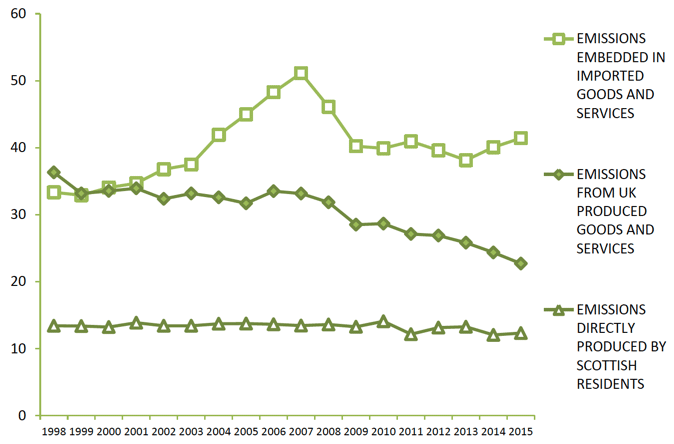
Additionally, Chart 2 shows that:
- Greenhouse gas emissions associated with imported goods and services increased from 33.3 MtCO2e in 1998 to 51.1 MtCO2e in 2007 (an increase of 53.4 per cent over this time period). These emissions accounted for 52.3 per cent of Scotland's carbon footprint in 2007.
- Between 2007 and 2015, greenhouse gas emissions embedded in imported goods and services fell by 19.0 per cent; this compares with a 24.3 per cent increase in emissions embedded in imports over the whole time period from 1998 to 2015.
- Greenhouse gas emissions relating to the consumption of UK produced goods and services by Scottish residents fell from 36.3 MtCO2e in 1998 to 22.7 MtCO2e in 2015 – a fall of 37.5 per cent. There was a general fall in greenhouse gas emissions from this category over the time period.
- Greenhouse gas emissions generated directly by Scottish residents have fallen from 13.4 MtCO2e in 1998 to 12.3 MtCO2e in 2015 – a fall of 8.1 per cent over this time period.
Chart 3 shows how Scotland's carbon footprint fell by 6.6 MtCO2e (8.0 per cent) between 1998 and 2015.
Chart 3. Change in Scotland's Carbon Footprint between 1998 and 2015 - in MtCO2e, and percentage changes
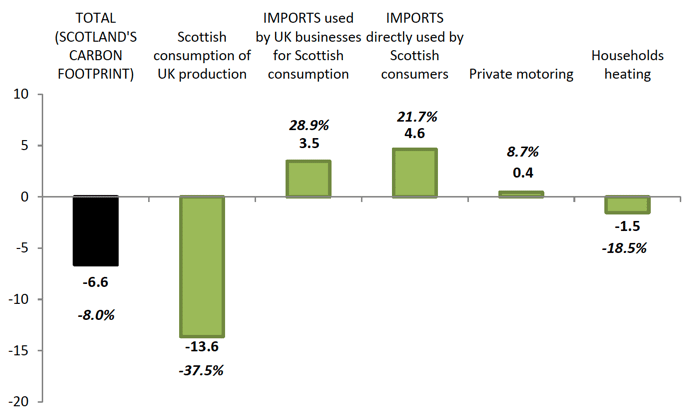
Chart 3 also shows that between 1998 and 2015:
- Greenhouse gas emissions from Scottish consumption of UK production have seen the greatest absolute reduction over this time period (13.6 MtCO2e; a 37.5 per cent reduction).
- Greenhouse gas emissions embedded in imports directly used by Scottish consumers have increased by 4.6 MtCO2e (a 21.7 per cent increase). Emissions embedded in imports used by UK businesses for Scottish consumption have increased by 3.5 MtCO2e (a 28.9 per cent increase).
- Greenhouse gas emissions resulting from households heating have decreased by 1.5 MtCO2e (an 18.5 per cent decrease) whilst private motoring emissions have increased by 0.4 MtCO2e (an 8.7 per cent increase).
Chart 4 shows how Scotland's carbon footprint has changed from 2007 to 2015. The year 2007 has been chosen as the base year for this chart as it represents the peak value in the series. Scotland's carbon footprint has fallen by 21.3 MtCO2e (21.8 per cent) over this time period.
Chart 4. Change in Scotland's Carbon Footprint between 2007 and 2015 - in MtCO2e, and percentage changes
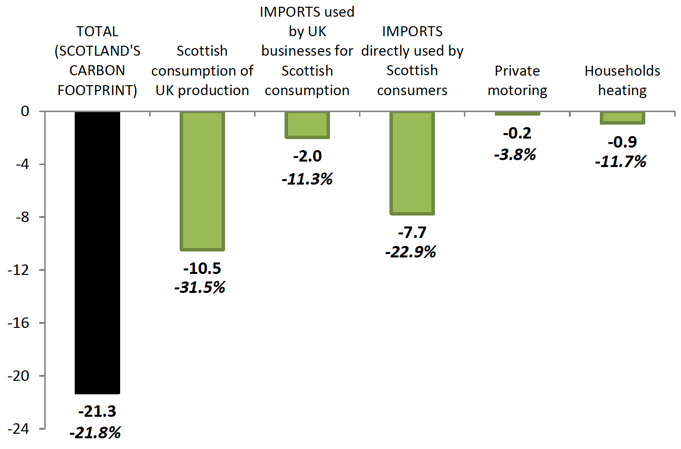
Chart 4 also shows that between 2007 and 2015:
- Greenhouse gas emissions embedded in Scottish consumption of UK production fell by the greatest amount, both in absolute and percentage terms (a reduction of 10.5 MtCO2e; 31.5 per cent).
- There were also considerable falls in greenhouse gas emissions attributed to imports directly used by Scottish consumers (7.7 MtCO2e; 22.9 per cent).
- Imports used by UK businesses for Scottish consumption fell slightly (a reduction of 2.0 MtCO2e; 11.3 per cent).
Greenhouse gas emissions attributed to private motoring and household heating have seen smaller absolute falls (0.2 MtCO2e for private motoring; 0.9 MtCO2e for households heating).
Chart 5 shows that Scotland's carbon footprint has maintained the same level between 2014 and 2015.
Chart 5. Change in Scotland's Carbon Footprint between 2014 and 2015 - in MtCO2e, and percentage changes
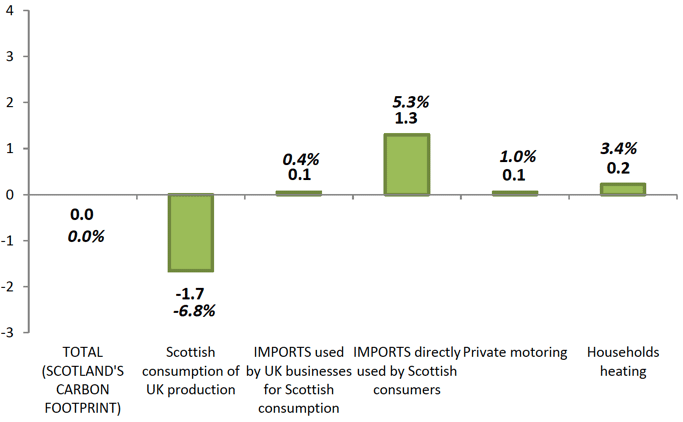
Chart 5 also shows that between 2014 and 2015:
- Emissions embodied in Scottish consumption of UK production fell by 1.7 MtCO2e (6.8 per cent).
- Conversely, embedded emissions in imports consumed in Scotland rose by 1.3 MtCO2e (5.3 per cent).
- There were relatively minor increases in the level of absolute emissions in Imports used by UK businesses (0.1 MtCO2e), private motoring (0.1 MtCO2e), and household heating (0.2 MtCO2e).
Chart 6 presents a breakdown of Scotland's embedded greenhouse gases by region of import.
Chart 6. Breakdown of Scotland's embedded greenhouse gas emissions by region of import, 1998 to 2015. Values in MtCO2e
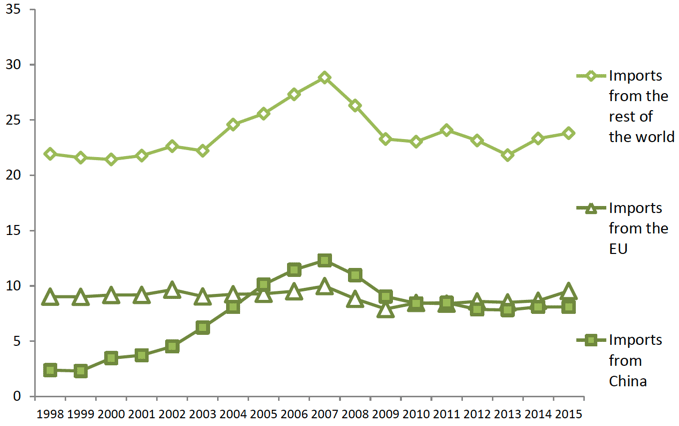
- Consistently over the entire time-series, over half of greenhouse gas emissions embedded in imported goods and services originate from areas other than the EU and China. Greenhouse gas emissions associated with these "rest of world" imports increased from 21.9 MtCO2e in 1998 to 28.8 MtCO2e in 2007 (a 31.5 per cent increase). They then fell sharply to 23.3 MtCO2e in 2009. Following 2009, these embodied emissions have been comparatively stable, initially falling and then rising slightly over this period to their 2015 level of 23.8 MtCO2e.
- Greenhouse gas emissions embedded in EU imports increased slightly from 8.0 MtCO2e in 1998 to 9.0 MtCO2e in 2007 before falling to their lowest point of 7.9 MtCO2e in 2009. Over the entire time-series, these embodied emissions show a modest overall increase of 5.7 per cent from 1998 to 2015.
- Greenhouse gas emissions embedded from imports to Scotland from China have increased from 2.4 MtCO2e in 1998 to 12.3 MtCO2e in 2007 (a five-fold (518 per cent) increase)). Emissions embedded in these imports fell for 3 consecutive years following the 2007 peak and have remained comparatively stable since that time. Over the entire time-series, embodied emissions associated with imports from China have increased by 240 per cent (1998-2015).
Contact
Email: Andrew Mortimer
There is a problem
Thanks for your feedback